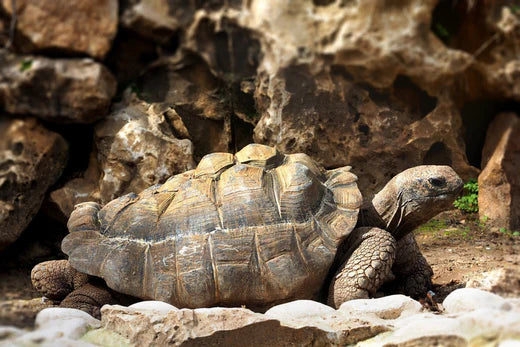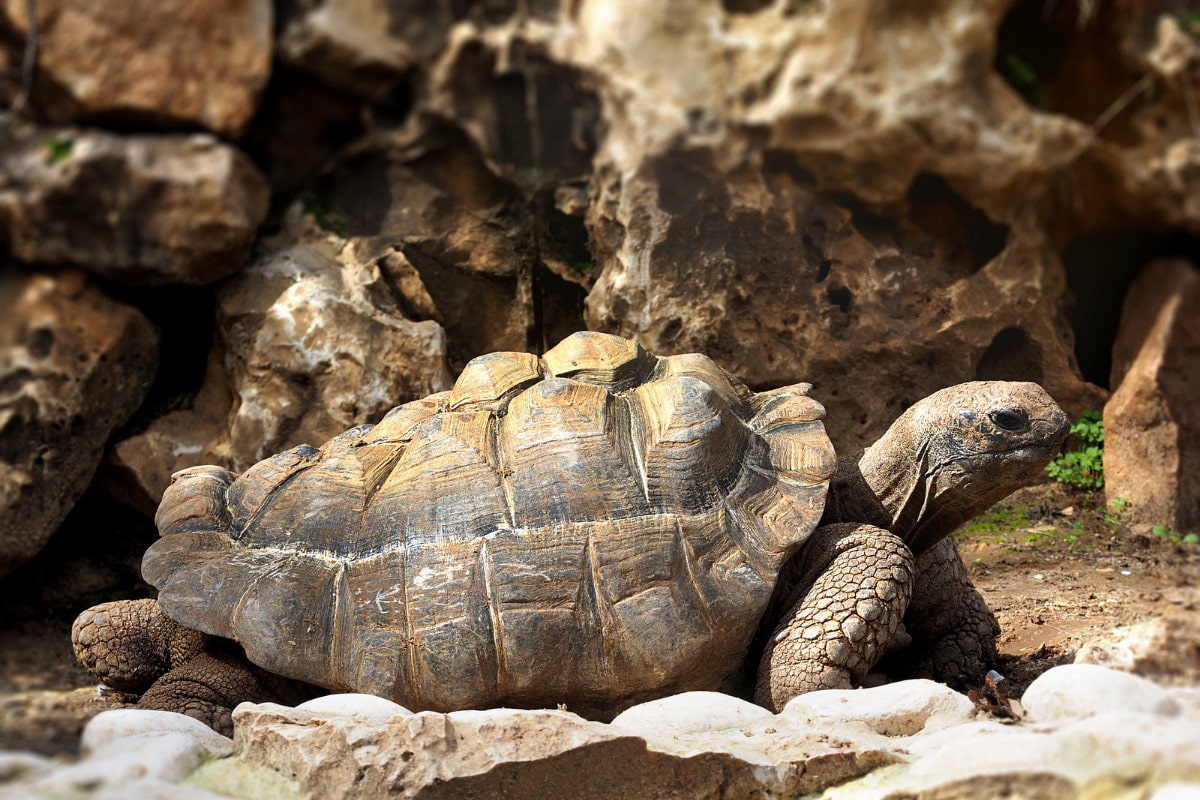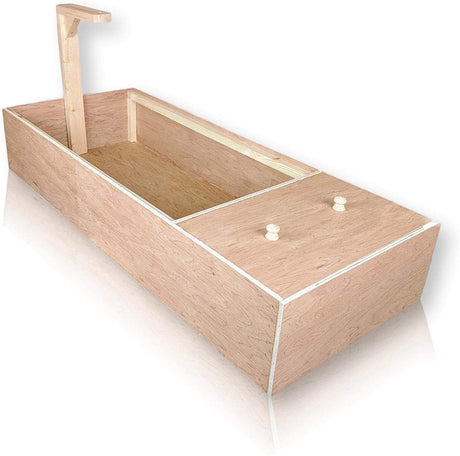Heat lamps are one of the many items you will be recommended for your tortoise, but why do they need one and how is best to use it? Here’s everything you need to know about having a tortoise heat lamp.

Why Do Tortoises Need Extra Heat?
If you look at where tortoises are found in the wild, you may notice that they all have one thing in common - from the Mediterranean to the jungle of Panama to the deserts of Egypt, all of these places are known to be relatively hot. When raising an animal in captivity, it is important that we try to replicate their natural habitat which includes maintaining the right temperature for them. While in the wild, this heat would come from natural sunlight, in the UK the conditions are not usually those required for a tortoise to remain healthy.
As cold blooded reptiles, tortoises cannot produce their own body heat, therefore, rely on an external source of heat to maintain their body temperature. Tortoises need a higher temperature so that they can complete all of their natural bodily functions. A higher temperature supports their metabolism and aids digestion which ensures they have enough energy to be able to look for food, find shelter, evade predators, or dig nests. Metabolising their food also enables them to synthesise calcium which is vital for their growth and development.
All in all, providing adequate heat is one of the main things you should consider when investing in your tortoise enclosure.
Heat vs Light
There are lots of different bulbs on the market when shopping for a tortoise therefore it is important to know the difference between those that emit heat and those that emit light because they are not the same thing.
Although tortoises need both heat and light to be able to survive, they each have different benefits. Light bulbs emit UVB light which encourages the metabolism of vitamin D which enables the tortoise to synthesise calcium. Calcium is vital in growing healthy bones and a healthy shell.
Heat, as we explained previously, is necessary because they need an external source of heat to maintain their body temperature to be able to perform normal bodily functions such as digestion and basic locomotion. Heat lamps emit a high level of heat that your tortoise will bask under to raise their body temperature to the optimum level. UV lights, on the other hand, are not needed for basking but to stimulate the natural levels of sunlight that a tortoise would receive as well the same daylight hours as in the wild.
You can buy combination bulbs that will provide both heat as well as UVB light, however you should always check to make sure that they will do everything you need them to!

How Can I Provide My Tortoise with the Heat it Needs?
Keeping your tortoise in the right conditions can be done in a variety of ways. Some people may buy heat lamps or heat mats, bulbs that provide heat and light, or lamps that emit no colour at all. However, there are some pros and cons to all of these options.
Heat Pads
Although heat mats make great heat providers for other reptiles such as lizards and snakes, we would not recommend them as the sole heat source for tortoises. Tortoises need to receive heat from above for it to be the most effective, due to the shape and surface area of their shell. With heat pads, the heat will be coming from below which will not have the same benefits to them and is said to be only 35% as effective.
Some people may attach heat pads to the sides of their tortoise enclosures which could be a better option but they still do not compare to the benefits of mounting a heat lamp. If you do want to use a heat pad, they do a great job of keeping them warm at night, however we recommend using them in conjunction with an overhead heat lamp.
Heat Lamps
Heat lamps come in a variety of shapes, sizes, and types. Each works in different ways and so you should do your research into which is best.
Mercury vapour bulbs produce heat and emit UVB light which is why they are also known as combination bulbs. If you were to buy a mercury vapour bulb then you would only need to buy one bulb for your setup rather than buying separate ones for heat and light. This has some obvious benefits, however, it means that you cannot just provide heat when it is time to turn the light off. If the room in which your tortoises are kept gets quite cold, then you may need a separate heat lamp to keep on at night.
Heat lamps that do only produce heat, and not UVB light, also have a variety of choices available to you. Those with a red glow are also known as a basking bulb and make great day lamps as they will increase the ambient air temperature of your tortoise’s environment which is great for your tortoise. Night time heat lamps, on the other hand, will give off a blue glow and will not impact your tortoise’s circadian rhythm, therefore can be left on throughout the night, independent of a UV light source. These are ideal if your house becomes cold at night and drops below their optimum temperatures.
Make sure you look into how to install your heat bulb correctly - too close and your tortoise can burn or become dehydrated, too far away and it won’t have the same benefits and your tortoise can become lethargic. Each heat bulb will have different recommendations depending on their wattage so take a look at the box and make sure you follow the instructions.
How Much Extra Heat do Tortoises Need?
Each species of tortoise will have different required temperatures to be able to thrive; Mediterranean tortoises may not need as much as those found in the desert. Here are some common species of pet tortoises and their recommended heat gradient:
- Mediterranean tortoises such as the marginated tortoise, leopard tortoise and the Greek tortoise need an ambient temperature of 25-30 degrees Celsius; it should be no lower than 15C at night and no more than no more than 35C under their basking lamp
- European tortoises can live a healthy life in low temperatures but shouldn’t be kept in anything that is consistently lower than 15C and their basking temperature should be around 32 degrees Celsius.
- Tropical tortoises such as the red-footed tortoise require much higher levels of heat and humidity so need an ambient temperature of 30C and no less than 35C under their basking lamp.

You can measure and monitor the heat gradient within your tortoise enclosure using high quality thermometers.
How Many Hours in a Day?
Unlike tortoise lighting that stays consistent to regulate your tortoise's circadian rhythm, your tortoise’s heating schedule can change depending on the time of year, natural heat, and how hot you keep your house!
In some scenarios, you may need to provide supplementary heating all day, every day to maintain the needs of your tortoise. Alternatively, if your house stays relatively warm throughout the night, and it is well insulated, then you could opt to turn the heating light off overnight.
Of course, if your particular species of tortoise hibernates, then you should adjust the temperature of your tortoise enclosure appropriately in preparation. Reducing the temperature slowly will prepare their systems for brumation and ensure they begin to follow the natural processes to begin a healthy hibernation.
Do All Species Need a Tortoise Heat Lamp?
In short, yes! Whether you are keeping your tortoise in a tortoise table or in an outdoor enclosure, all species of tortoise need a higher temperature than what is natural in the UK. Unless you live in a country where the natural temperature mimics those that your tortoise would experience in the wild, you should always provide supplementary heating to ensure that they live a long and healthy life.
Without the correct heating or conditions, your tortoise could develop life-threatening illnesses such as shell rot, metabolic bone disease, or respiratory infections.
Maintaining Your Tortoise Enclosure Temperature
If you keep your tortoise indoors in a tortoise table then there may not be as much variation in different temperatures, however you should check for draughts throughout the day, and make sure that it is not too hot under the basking lamp, and not too cold at the opposite end of their enclosure. At the same time, you want to check that there is a noticeable difference throughout the enclosure so that your tortoise can remain comfortable and choose where they want to be.

Additionally, although a radiator may seem a great source of additional heat, they can drastically dehumidify the air and can have negative effects on your tortoise. It’s best to keep your tortoises away from radiators however, if that’s not possible, always monitor the humidity levels by using a hygrometer and spraying the enclosure down with some water, if needed
If you keep your tortoise outside in your garden, for example, then you should expect much more variation and should be prepared to provide additional heating all year round. Make sure you position your heat lamps tactically to ensure your tortoise gets the warmth they need to survive. Although there may be plenty of natural light outside, this is not always sufficient for your cold blooded reptiles if the air temperature is too low.
You can use thermostats to monitor the temperature; if you set them correctly, they will turn the lamp or mat on and off automatically as and when it is needed.
Keep Your Tortoises Happy
Whether you have a couple of hatchlings in a tortoise table or an adult tortoise free roaming in your garden, you should always consider the levels of heat that they are receiving and whether or not it is enough for them to remain healthy.
We hope this guide has been useful and you are confident in providing your tortoise with the right environment to thrive!




